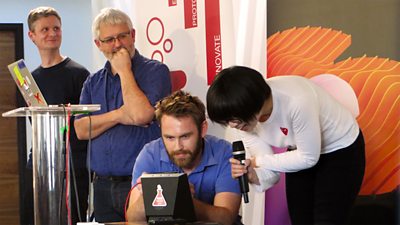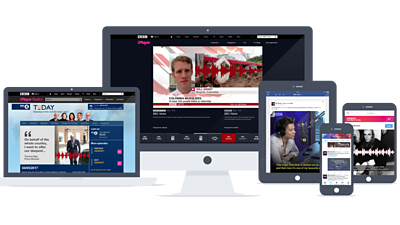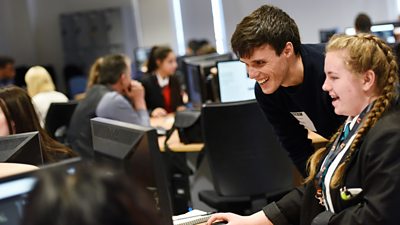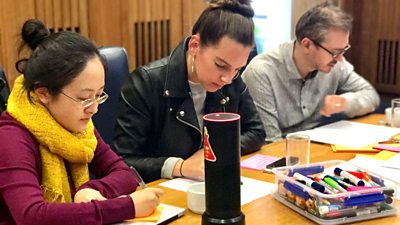It’s been a busy year for writes Allison Shultes. Our team kicked off the corporation’s experiments with news for voice devices in January and continued to prototype for Google ±«Óătv and Amazon’s Alexa over the course of the year. We developed new tools to help our colleagues in radio make their output more attractive on social media, worked with the World Service on bespoke chatbots for Facebook Messenger and the News website, and continued to promote industry collaboration by hosting three international hackathons.
Here’s a recap of our biggest successes from the year and our plans for carrying them forward into 2018.

Prototyping for Voice Devices
One of our biggest projects this year has been thinking about how to bring ±«Óătv content to voice devices. Our interest in this area began at , where Labber Lei He developed a Google ±«Óătv action that reads out ±«Óătv News stories. After further development it proved interesting enough to show to Tony Hall, the Director-General.
Since then, Labs has been heavily involved in the ±«Óătv’s voice work, helping to lead the way onto new platforms and devices. We built and trialled a new audience-facing Alexa skill this autumn, and found that there is an appetite for consuming news using the voice interactions we designed. We hope to iterate on these initial experiments and integrate more complex machine learning in some of the editorial tooling we have built for producing bespoke content for voice.
Because of our team’s early experiments, Head of Labs Miles Bernie was selected to lead the corporation’s voice skunkworks project this summer. He worked with editorial and technical colleagues to come up with radical new possibilities for how the ±«Óătv might sound on Amazon Echo or Google ±«Óătv. The ideas generated during the project, as well as the connections formed with other teams within the ±«Óătv, will help drive our work on voice in the new year.
Bot-Building
Our team continued to explore innovative ways of driving engagement via conversational platforms such as Facebook and Twitter. for the “So I Can Breathe” season, inviting audiences to test their knowledge of air pollution. Our Google News Labs Fellow Varun Krishnan kicked off a stream of work to offer more personalised news to Facebook users who subscribe to the Mundo Messenger bot, which we built and launched in 2016.
to explain complex subject matter - for example, the people selected to serve in US President Donald Trump’s cabinet. We plan to continue with the project by prototyping a tool for editorial staff to easily build their own bots and adding more detailed analytics to track audience use.
Shareable Radio and Discoverable Podcasts

One of our most widely-used projects this year was , initially developed by the New York radio station . Audiogram was conceived to make audio more shareable on platforms like Facebook and Twitter, which - in contrast to video - don’t autoplay audio content. By generating a moving waveform and turning the audio into a video file, Audiogram allows radio content to autoplay in people’s feeds.
By integrating the tool with some of our , graduate trainee Jonty Usborne added support for burning in subtitles, allowing that autoplaying video to be even more attractive. This has increased audience interaction with ±«Óătv radio output on social media.
In addition to making radio content more shareable, we also began experimenting with making the ±«Óătv’s podcasts more discoverable. Labber Fionntan O’Donnell developed an initial user interface built off of a similarity engine to generate podcast suggestions for a given article. After discussions with our editorial colleagues, we’re thinking about development of an internal suggestion tool to encourage better onward journeys to related podcasts from other parts of the ±«Óătv News website.
#newsHACKs

News Labs has continued to drive innovation across the industry, as well as within the ±«Óătv. We held three #newsHACK events this year, bringing together teams of journalists and developers from across the UK and Europe to solve common challenges and opportunities in the media.
Our was held in collaboration with the pan-European SUMMA consortium, which is building a platform for multilingual media monitoring using the latest cutting-edge language technologies from research at universities. We also held events on and in January and October of this year. We plan to continue hosting these events in the new year, exploring opportunities in language technology and on voice devices.
Outreach and Engagement
We’ve also been sharing our work in News Labs outside of our hackathons. Labbers Dave Bevan and Alex Norton represented our team at this year, the world’s leading media, entertainment and technology show. Dave spoke on a panel discussing automation in the newsroom, and Alex presented a paper he co-authored on applications of speech-to-text technology with R&D’s Andrew McParland. The paper, “Speech-to-Text for Broadcasters, from Research to Implementation”, will be published in the SMPTE Motion Imaging Journal this spring.
We to write and present for delivering more personalised and time-aware news to the country’s consumers. Once pitches have been evaluated and a winner selected, News Labs will provide technical support and expertise to the company chosen to develop its idea. We hope that by helping to address this market gap, we’ll help expand the reach of our Delhi bureau in support of the World Service’s goals.

In addition to our industry events, we’ve also been sharing the work we do with secondary school children and university students. We ran two days of workshops on web application development as part of the ±«Óătv’s Digital Taster Day at Teesside University, and then brought the tutorial to the Manchester United Foundation at the Women in STEM day in Salford this autumn. We also have a University Challenge planned for the new year, inviting computer science and journalism students to build prototypes for voice devices. We believe this work helps encourage young people to get excited about media technology and consider careers at the ±«Óătv.

And finally, we’ve been making a concerted effort to raise awareness of our tools in the newsroom. With the help of the team, we ran editorial tooling workshops in London and Media City to introduce editorial staff to some of our more robust production prototypes. We also built an internal website called News Labs Toolkit to showcase our most production-ready prototypes — tools that are already in use by ±«Óătv staff. By bringing together all of these prototypes in one place, and including easy-to-follow instructions, we hope to raise awareness of our experiments in the newsroom.
- -
